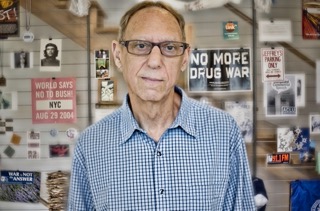‘Having a voice matters’
Waving colorful homemade posters and blue union authorization cards, several dozen Albemarle County teachers and community members rallied in front of the County Office Building last Thursday evening, urging the county school board to allow school employees to unionize. In late March, the Albemarle Education Association submitted to the board a draft collective bargaining resolution, which supporters say could boost pay, improve contracts, and provide other benefits. More than two-thirds of teachers, transportation staff, and school nurses have signed union cards.
After the crowd marched into the building, several teachers and union supporters told the school board about the desperate need for collective bargaining. The resolution was listed on the meeting’s agenda as an information item, but it was not discussed.
“Employees having the right to negotiate their contracts is a key way to retain the experienced workforce of [ACPS] employees,” said Albemarle Education Association President Vernon Liechti during public comment. “Having a voice matters.”
Teacher Mary McIntyre criticized the school division for not giving pay raises to middle- and high-school teachers with more than 150 students, violating state law. Art teacher Donna Evans claimed she had over 250 students last year and was not properly compensated until she went through a lengthy grievance process.
“This intense schedule has indeed affected my health,” said Evans. “I feel taken advantage of, and truly not valued.”
When former teacher David Zatyko worked for the division, he noticed that many teachers had to get a second or third job in order to make ends meet. “Collective bargaining will help promote a workplace environment where teachers are not thrown to the wolves,” he said.
Bekah Saxon of the Virginia Education Association called on the board to meet with the AEA, and start negotiating a collective bargaining agreement as quickly as possible.
“Having some silence now is causing us a whole lot of angst,” said Saxon. “We don’t want this to become hostile or all about the lawyers fighting things out.”
Last month, the Charlottesville Education Association submitted its own collective bargaining resolution to the city school board. The county and city boards have until July 22 and August 12, respectively, to respond to the proposed resolutions.
FOIA fracas
After receiving dozens of pages of redacted emails and letters in response to his FOIA requests from the City of Charlottesville last month, civil rights attorney Jeff Fogel—along with local activists Cherry Henley and Tanesha Hudson, and journalist Dave McNair—filed a lawsuit claiming the city violated their constitutional rights and FOIA rules by refusing to disclose how much it paid out in police misconduct settlements from 2017 to 2021.

In its FOIA response, the city claimed that several state codes allowed it to redact “personnel information,” information covered by “attorney-client privilege,” and attorney “work product,” reports The Daily Progress. Fogel disagrees that these codes applied to all five of the cases included in the response.
When the city’s insurer, the Virginia Risk Sharing Association, pays out settlements, claimants are required to sign non-disclosure agreements. The plaintiffs want Charlottesville Circuit Court to issue a declaratory judgment that the city’s non-disclosure policy violates the First Amendment, as well as prohibit the city from enforcing Hudson’s non-disclosure agreement related to her settlement and award them attorney’s fees and other costs, according to the joint complaint.
In brief
Cutting carbon
Charlottesville’s Climate Protection Program has launched two community surveys, requesting input on how the city can meet its goal of reducing greenhouse gas emissions by 45 percent by 2030—and achieving carbon neutrality by 2050. Both surveys are open until May 20. To take the surveys, visit charlottesville.gov/climateplan.
Free bikes
In partnership with the Tonsler Basketball League and We Code Too, former city councilor Wes Bellamy is raising money to give 300 bicycles to kids and teens from low-income Charlottesville communities. The organizers are collecting donations on GoFundMe until May 6, and will distribute the bikes at Tonsler Park on June 5.
False alarm
Early Thursday morning, several UVA officials received emails from a person “threatening harm” to the school, according to an email sent to the university community. After investigating the source of the threat, the University Police Department “determined that no credible threat exists to warrant any immediate action.”
Denver’s done
Former 5th District Republican representative Denver Riggleman has stepped down from his role as a senior advisor to the House of Representatives committee investigating the January 6 insurrection, and taken a new job with a nonprofit in Ukraine. Riggleman will “support efforts assisting Ukrainian refugees and non-lethal mission areas,” according to his resignation letter. After being defeated by hardcore conservative Bob Good in a 2020 primary, the one-term rep became one of the few Republicans to criticize the Capitol siege and join the investigation.
And stay out
Unite the Right organizer Jason Kessler has been banned from UVA Grounds again—and this time, for good. Last week, the University Police Department renewed its no-trespassing order—issued after Kessler threatened students at UVA’s School of Law library in 2018—against the University of Virginia grad. The university’s no-trespassing orders against nearly a dozen other white supremacists are set to expire in October.

















